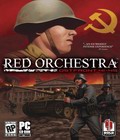Genre: First-Person Shooter
Publisher: Bold Games
Developer: Tripwire Interactive
Release Date: March 13, 2006
30 April 1945: Plumes of thick acrid smoke from destroyed tanks and shattered buildings drifted above Berlin's once-majestic KönigsPlatz, now deformed by artillery and makeshift barricades into an eerie and desolate landscape. Small arms fire popped intermittingly in the distance, and the clatter of tank treads echoed across vacant streets. As artillery shells arced overhead, a helmeted figure clad in a muddy brown-green uniform rose above a sandbag wall and blew fiercely on a whistle. Dozens of men emerged from behind rubble and clambered out of craters to charge towards their prize: the Reichstag, Germany's long-vacated seat of power.
Muzzle flashes began appearing along the German line, and the cacophony of battle grew louder as a MG42 joined in with its distinctive "ripping-cloth" report. The soldiers of Russia's 150th Rifle Division instinctively hunched forward as bullets sliced through the air and tore up the ground around them. As the wave of steely-eyed men drew closer to their enemy, they returned fire with their deadly PPSh submachine guns and tossed grenades into the midst of the stalwart defenders. Yet no sooner had the Russians approached the steps of the Reichstag when a Tiger tank painted the color of summer wheat lurched over a dirt berm and began raking the exposed troops with murderous machinegun fire ….
And so continued my battle for the KönigsPlatz, one of several scenarios in Tripwire Interactive's new first-person shooter, Red Orchestra: Ostfront 41-45. Based on their award-winning Unreal mod, Red Orchestra is a fully-featured, stand-alone game of realistic one-hit-one-kill combat on the Eastern Front during World War II. The game's impressive features include several infantry types for the Russian and German armies, 24 different infantry weapons, the ability to call in artillery strikes, 14 crewable vehicles, 13 maps representing key battlefields on the Eastern Front, and both single and multiplayer game modes.
Red Orchestra is available as a download via Steam – publisher Valve's electronic distribution platform – or off the shelf on CD-ROM for a slighter higher price. Gamers interested in the title should be aware that in Internet connection is necessary for activation during installation, even if you buy the CD version. Steam is also used to automatically upgrade the game as patches are released. This is a great system to ensure players have the latest version of the game, and it also means you don't have to have the CD in the drive once the game's installed. Conversely, the requirement to have Internet access will unfortunately put the title out of some gamers' reach.
To help you get into the action, a Quick Start Guide is included, covering issues such as installation and in-game controls. I'd recommend at least having a glance at the guide, as there are some commands that aren't normally found in a first-person shooter, such as "Attach Bayonet or Deploy MG" and "Change MG Barrel." A more comprehensive guide is available for download in PDF format and covers every aspect of the game in detail. There are no tutorial missions per se, but on-screen advice is available when the game is first played. The AI's difficulty in offline, or "Practice" mode, and the number of soldiers on a map also can also be adjusted to make the game easier for newcomers to get up and running - and shooting!
After launching the game, the main menu displays options for Multiplayer, Practice, Configuration, Help and Game Management, and Hosting. Although Red Orchestra is primarily a multiplayer game, the single player, or "Practice" mode, is very robust and a good place to start. At its core are several maps from which to choose, much like what you'd find in the Battlefield series, with each having various geographical, as opposed to mission-based, objectives. There is no campaign, underlying story, or character development to be concerned about, with the designers focusing their efforts on getting the fundamentals right – namely, a historically accurate, immersive, and challenging game experience. The multiplayer game is, as you might imagine, even more challenging, and the built-in browser, with its customizable filters, makes finding a game server a painless affair.
Having selected a map, you can adjust certain gameplay properties in the Practice mode, like AI difficulty, the number of AI soldiers or bots on the map (up to 32), and for how long the game runs. Multiplayer games can be run on a Local Area Network server or over the Internet, again with up to 32 players participating. When hosting games, you have the ability to select the map, adjust server settings, game rules, and voting options.
When the map is loaded – which unfortunately does take several minutes – you have the option of choosing which side you want to fight for, what infantry class you want to start the game as, or whether you just be an observer. Both the Russians and Germans have similar class types, including rifleman, sniper, submachine gunner, sapper, anti-tank, medium machine gunner, tanker and platoon leader. In some cases, there are different weapons available for the same class of soldier. A German machine gunner, for example, may have the option of choosing a MG34 with drum magazine or a belt-fed MG42. The character selection screen also provides access to an overview of the map you're about to fight on. It displays key buildings, objectives and other useful information, like radio locations and re-supply depots. The map is also accessible at any time during game play by pressing the "Show Situation Map" key.
When your character has spawned on the game map, additional information is visible in the bottom corners of the screen, such as your health, weapon type, ammunition, stance, and compass. For a more realistic experience, the head's-up display, or HUD, can be turned off completely. It's also worth noting that there is no mid-screen crosshair as in most other shooters, forcing players to use their gun's iron sights to aim accurately. By default, your view is in first person, although this can be changed to third-person. While the latter can be useful in some instances to aid with situational awareness, the majority of the game will need to be played in first-person mode, especially as this is the only way to shoot with any accuracy.
In addition to walking, soldiers can sprint, crouch, run low, crawl and jump. Running affects your stamina, and this displays as a red outline on the soldier posture icon in the lower left corner of the HUD. Other cues that your soldier is becoming tired include the sound of heavy breathing and a reduced rate of movement. It's an effective and realistic representation, and you quickly learn to sprint only when it's necessary. One less realistic movement is jumping. Perhaps a legacy of the game's Unreal origins, AI soldiers can jump ridiculously high as if wearing anti-gravity combat boots. Finally, a soldier can receive wounds in one or more areas that may have a dramatic effect on movement. The locations of wounds are marked in red on the posture icon. Being wounded can have other results too, such as making you drop your weapon if you're hit in the hand. In addition, there are no health packs scattered about the map or medics who can shock you back to life. You stay wounded until the game ends or you're killed outright. Fortunately, the designers did make some compromises in that a serious wound will not incapacitate you. In the event of being killed, your character respawns some distance from the action. It's possible to keep respawning as long as there are "reinforcements," or spare lives, available.
As many of the maps in the game have vehicles, it's possible to crew a tank position such as driver, commander/gunner or hull gunner, but only if you selected to spawn as a tank crew. Although you can't drive and shoot at the same time, it is easy to swap between positions, even if they're occupied by AI bots. Most positions in a tank also have multiple views. The driver, for example, has a standard and close-up view through his vision slit and can also open the hatch and look around, albeit at the risk of being shot. Similarly, the commander/gunner can choose to look through the gun sight or pop open the hatch and use his binoculars to scout around for enemy activity. Players can fire a tank's main guns and machineguns, with each having their own realistic recoil and load times. Tanks also have the option of firing both armor-piercing and high-explosive rounds. Other armored vehicles that are operable by all class types include the ubiquitous German SPW 251/1 half-track and the fast, but highly unstable, Soviet BA-64.
Graphically, Red Orchestra is excellent with dynamic lighting, trilinear filtering, HDR bloom, and all manner of visual wizardry being employed to great effect. Depending on your computer's specifications, the detail on the maps and soldiers at the highest levels is jaw-droppingly gorgeous. The terrain textures, lighting, level of detail in the buildings, vehicles and soldiers are sharp and accurately colored. If it weren't for the fact that you'd get shot, it would be tempting to just stare at your surroundings and take it all in. Despite all of this, there is the odd graphic anomaly or two, such as wheat being able to penetrate armored vehicles as you drive through fields and men standing in mid-air when they're climbing over an object, but these are rare and will hopefully be addressed in future patches.
Similarly, the various animated effects including explosions and reloading of weapons is second to none. Reloading weapons is not automatic and requires pressing the keyboard reload key, or, as in the case of most bolt-action rifles, another click of the mouse's "firing" button. In the case of German machine guns, an overheated barrel can be changed, and this process is also fully animated. Heavy weapons, such as the Russian PTRD anti-tank rifle, have fearsome recoil, which is simulated by the screen shaking wildly from side to side. Smaller automatic weapons, like the rapid-firing PPSh or MP40 submachine guns, have a tendency to arc upwards when fired in long bursts. Crouching or lying down and looking over the iron sights with these and other weapons markedly reduces this recoil.
Complementing the game's excellent graphics are first-rate sound effects. From the complex firing and reloading of weapons to the simple opening of a barn door, the developers have created a very believable auditory image. One of my favorite series of sound effects occurs when calling in artillery. From the radio chatter, to the distant "womp, womp, womp" of guns firing miles behind the front, to the final cacophony of explosions as the shells hit their targets, is as realistic as it gets in a video game. There is, however, some tweaking that still needs to be done in the audio department, such as the turret rotation sound. It's fine to hear this sound inside the tank, but it shouldn't be heard across the battlefield above all other sounds.
Sound is not restricted to explosions and cries of dying men either, as verbal communication has a useful role in the game. This includes VOIP in multiplayer and a set of built-in voice commands that are accessible by pressing a series of keyboard shortcuts. Admittedly, having to find and type in several keys during the heat of battle to say "Attack target X" is not ideal. Battlefield 2's context-sensitive communications handles this process much better, but at least it is available and does help improve the coordination of your team's actions – providing you remember keep your head down while issuing commands.
As some gamers may prefer the single-player experience to multiplayer, a brief assessment of Red Orchestra's AI might be helpful. One the one hand, it is scalable to suit your experience, and at the more difficult settings, the enemy can be excellent shots and aggressive. On the other hand, the actions of bots can at times range from amusing to downright annoying, which is particularly evident when it comes to their operation of vehicles. At times, the AI seems to know what it's doing, and bots will crew tanks and drive off towards the enemy, but then you will see them jump in and out of their vehicles and abandon them for no apparent reason. If a bot jumps into your vehicle as a driver, it has no idea you might be trying to get off a shot and will speed off towards some unseen enemy. Pathfinding is a problem, too, and the AI will often drive a tank into places from which it can't easily escape, and then abandon it.
Pathfinding problems apply to infantry as well, who comically get stuck in doorways when two or more try to pass through. Generally, bots don't work as a team, either. Sure, they may have the same objective, but they're mostly doing their own thing. Occasionally, you may see two in a tank, but more often than not, there are tank crews running around, shooting at the enemy with their pistols instead of joining a colleague in a tank. Despite this, my overall impression of the AI is generally favorable, particularly as it's really designed for practice prior to participating in online battles, and it's certainly capable of putting up a decent fight.
Red Orchestra has been described as the thinking man's shooter, and that's a fair call. Its emphasis on historical accuracy and real-world physics places it in my book as a notch above other titles in the genre, but just because the developers have striven for realism doesn't mean the game isn't fun, because it is. The maps are well constructed to keep gameplay fluid, and the number of different soldier classes and drivable vehicles means there's plenty of variety. One of my main concerns about games in general is their replay value, or, in many instances, the lack of it. Because Red Orchestra is not reliant on a story or linear gameplay and has plenty of variety, it remains a fresh and a different experience just about every time it's played. With only a few areas requiring improvement, Red Orchestra is about as good as it gets when it comes to historical first-person shooters.
Score: 8.6/10
More articles about Red Orchestra: Ostfront 41-45












 Red Orchestra: Ostfront 41-45 is a full-featured, stand-alone World War II FPS game that brings players to the frontlines of Eastern European combat during the height of World War II.
Red Orchestra: Ostfront 41-45 is a full-featured, stand-alone World War II FPS game that brings players to the frontlines of Eastern European combat during the height of World War II.









































